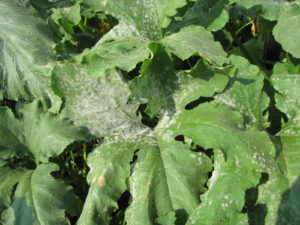Powdery mildew is a common disease of cucurbits in Indiana. This disease is more common on cantaloupe and pumpkin. However, we have observed powdery mildew more frequently on watermelon in recent years. We have also observed this disease on cucumber in high tunnels. If left uncontrolled, this disease can cause loss of foliage, loss of yield and lower quality fruit. This article will discuss the biology and management of powdery mildew of cucurbits.
Powdery mildew is relatively easy to recognize; talc-like lesions occur on both sides of the leaf (Figure 1). The fungus that causes powdery mildew, Podosphaera xanthii, does not require leaf wetness for infection of leaves, only high humidity. The optimum temperature for disease development is 68 to 81°F. P. xanthii may survive for a period in crop residue as a resilient fungal structure, but the disease is so easily windborne, that crop rotation is not always a practical control measure. The fungus that causes powdery mildew of cucurbits does not cause powdery mildew on other plant families. In the same way, powdery mildew of other plant families does not affect cucurbits.
Cantaloupe growers will want to apply systemic fungicides for powdery mildew management 10 to 14 days before first harvest. Applications should be maintained throughout much of harvest. Watermelon have traditionally not been affected by powdery mildew as much as cantaloupe. But watermelon growers who are concerned about powdery mildew should make the first application when fruit are about softball stage since powdery mildew can affect watermelon fruit. Powdery mildew does not require leaf wetness-this disease should continue to cause problems in dry weather.
Pumpkin growers should consider starting fungicide applications when the vines reach the ‘bush’ stage. That is, when the plants have grown upright just before they start vining out. At this stage, the humidity in the plant canopy can help powdery mildew colonies on the leaves to initiate.
The next article discusses fungicide recommendations for cucurbit powdery mildew.
